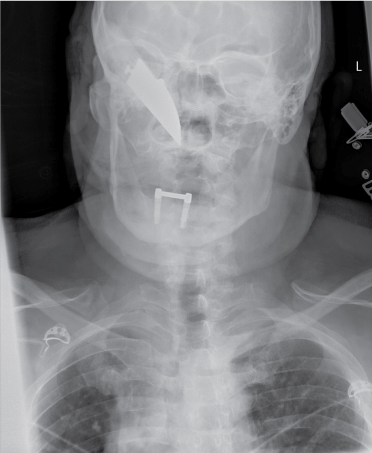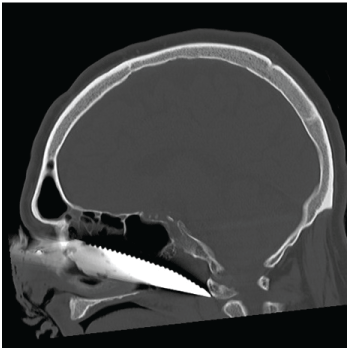A merciful knife penetrated the face of a 65-year-old man when he fell on his face in his kitchen.
The paramedics brought a 65-year-old male to the emergency department after falling in his kitchen. The patient was a known case oligodendroglioma for which debulking surgery was performed in 2012.
On examination in the emergency department, the patient was alert and awake. He was hemodynamically stable. A knife was identified penetrating the medial side of his face, just below the right eyeball.
The wound was closely examined, and it appeared to have a great depth. Considering the depth and the position of the penetration, the knife was considered sharp and pointed, which had penetrated through with a great force.
Since the patient was fortunate enough to be hemodynamically stable with normal vitals- which meant that no major vessels were penetrated along the course of knife penetration, it gave surgeons and the emergency team to evaluate the wound further to plan thoroughly; therefore, a plain X-ray was planned to know the knife’s trajectory.
The plain radiograph showed the knife had penetrated outside the neurocranium, with the tip extending just anterior of the first cervical vertebra.

A contrast-enhanced cerebral computed tomography scan was performed to examine the affected facial structures and the exact positioning of the knife. The CT scan showed that the knife was penetrating from the medial side of the orbita, along the maxillary sinus, through the medial pterygoid plate and nasopharynx, ending at the right anterior arch of C1.

The CT scan also revealed that the eyeball and the ocular muscles remained unaffected and untouched.
Fortunately, the internal carotid artery was also unscathed.
The patient was shifted to the operating room to remove the knife safely. He was given antibiotics prior to the procedure and after tracheal intubation.
During the surgery, some loose bone fragments were seen through the stab wound. A nasal fracture was identified, which was fixed with two small plates by the craniofacial surgeon. A small tear of the dorsal pharynx was stitched. There was no significant bleeding during the extraction of the knife.
The patient was shifted to the intensive care unit postoperatively, and he was safely extubated there. The post-op course was uneventful, and the patient remained stable. He was discharged the next day with a prescription of oral antibiotics for a week.
At the follow-up, the patient had recovered uneventfully.
Reference:
Van Vugt R, Peters J (2016) A Peculiar Case. Trauma Cases Rev 2:030. 10.23937/2469-5777/1510030




